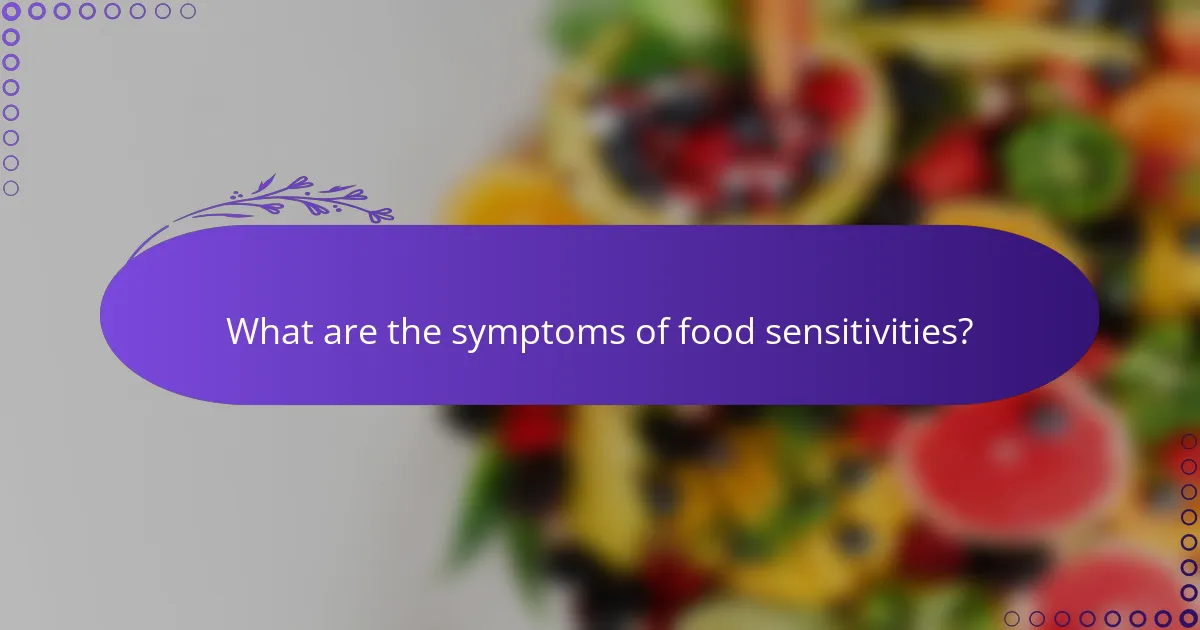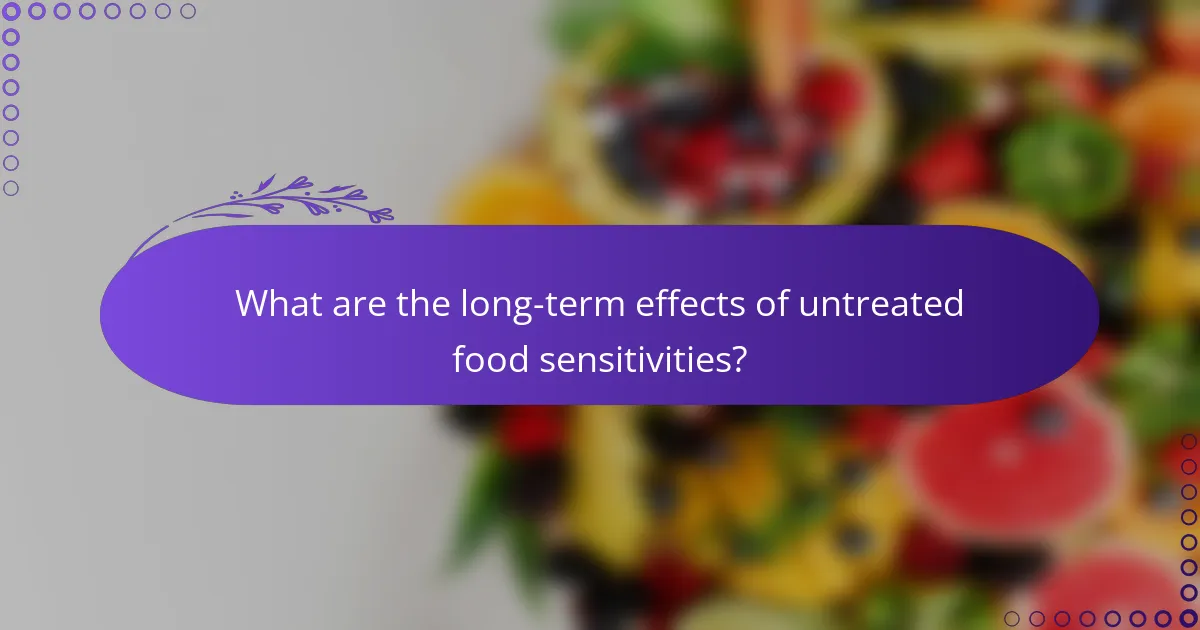Food sensitivities, such as lactose intolerance and gluten sensitivity, can cause significant discomfort and digestive issues when certain foods are consumed. Identifying these sensitivities often involves methods like elimination diets and symptom tracking, which help pinpoint specific triggers. By making informed dietary adjustments and replacing problematic foods with suitable alternatives, individuals can alleviate symptoms and enhance their overall well-being.

What are the common food sensitivities in the United States?
Common food sensitivities in the United States include lactose intolerance, gluten sensitivity, fructose malabsorption, histamine intolerance, and sensitivity to food additives. These conditions can lead to various digestive issues and discomfort when certain foods are consumed.
Lactose intolerance
Lactose intolerance occurs when the body lacks sufficient lactase, the enzyme needed to digest lactose, a sugar found in milk and dairy products. Symptoms typically include bloating, gas, and diarrhea after consuming dairy.
To manage lactose intolerance, individuals can limit or avoid dairy products or opt for lactose-free alternatives. Many find that hard cheeses and yogurt are easier to digest due to lower lactose content.
Gluten sensitivity
Gluten sensitivity, or non-celiac gluten sensitivity, involves adverse reactions to gluten, a protein found in wheat, barley, and rye. Symptoms may include abdominal pain, fatigue, and headaches, which can occur after gluten consumption.
Those with gluten sensitivity should avoid foods containing gluten and consider gluten-free grains like rice, quinoa, and corn. Reading labels is crucial, as gluten can be present in unexpected products.
Fructose malabsorption
Fructose malabsorption occurs when the body has difficulty absorbing fructose, a sugar found in many fruits, honey, and some sweeteners. This can lead to symptoms such as bloating, gas, and abdominal pain.
To manage this condition, individuals should limit high-fructose foods, focusing instead on low-fructose fruits like bananas and berries. Keeping a food diary can help identify trigger foods and monitor symptoms.
Histamine intolerance
Histamine intolerance arises when the body cannot break down histamine effectively, leading to symptoms like headaches, hives, and digestive issues after consuming histamine-rich foods. Common sources include aged cheeses, fermented foods, and certain wines.
Managing histamine intolerance involves avoiding high-histamine foods and incorporating fresh, unprocessed options. It’s also helpful to consult with a healthcare provider for personalized dietary advice.
Food additives sensitivity
Some individuals experience sensitivities to food additives, such as preservatives, colorings, and flavor enhancers. Reactions can range from mild to severe and may include headaches, skin rashes, or gastrointestinal distress.
To reduce the risk of adverse reactions, it’s advisable to read ingredient labels carefully and choose whole, minimally processed foods. Common additives to watch for include sulfites, MSG, and artificial colors.

How can food sensitivities be identified?
Food sensitivities can be identified through various methods, including elimination diets, food sensitivity testing, and symptom tracking. Each approach helps pinpoint specific foods that may trigger adverse reactions.
Elimination diet
An elimination diet involves removing potential trigger foods from your diet for a period, typically 2 to 6 weeks. Common culprits include dairy, gluten, soy, and certain nuts. After this period, foods are gradually reintroduced one at a time to observe any reactions.
It’s crucial to maintain a balanced diet during this process to avoid nutritional deficiencies. Consulting a healthcare professional can provide guidance and ensure the elimination diet is conducted safely.
Food sensitivity testing
Food sensitivity testing can help identify problematic foods through blood tests or skin prick tests. These tests measure immune responses to specific foods, providing insights into sensitivities. However, results can vary, and not all tests are equally reliable.
Before opting for testing, consider discussing it with a healthcare provider to understand the best options available and what the results might mean for your dietary choices.
Symptom tracking
Symptom tracking involves keeping a detailed diary of food intake and any related symptoms. This method can help identify patterns and correlations between specific foods and adverse reactions. Note the timing of symptoms, as they can occur immediately or be delayed by hours or even days.
Using a simple checklist can enhance this process: record what you eat, when you eat, and any symptoms experienced. This information can be invaluable for discussions with healthcare professionals about potential food sensitivities.

What dietary adjustments can help manage food sensitivities?
Dietary adjustments for managing food sensitivities involve identifying trigger foods and replacing them with suitable alternatives. These changes can help alleviate symptoms and improve overall well-being.
Incorporating alternative ingredients
Substituting trigger ingredients with alternatives is crucial for managing food sensitivities. For example, if gluten is a concern, options like almond flour or coconut flour can be used in baking. Similarly, lactose-free dairy products or plant-based milks can replace regular dairy.
When incorporating alternative ingredients, ensure they provide similar nutritional benefits. For instance, if replacing wheat pasta, consider whole grain or legume-based pasta for added fiber and protein.
Meal planning strategies
Effective meal planning can help avoid accidental exposure to trigger foods. Start by creating a weekly menu that emphasizes safe ingredients and includes a variety of foods to ensure balanced nutrition. Batch cooking and prepping meals in advance can save time and reduce stress.
Keep a list of safe and unsafe foods handy while shopping. This can help you make informed choices and avoid impulse buys that may contain allergens or irritants.
Consulting a registered dietitian
Working with a registered dietitian can provide personalized guidance for managing food sensitivities. They can help identify specific triggers through dietary assessments and suggest appropriate substitutions tailored to individual needs.
A dietitian can also assist in developing a balanced meal plan that meets nutritional requirements while avoiding problematic foods. This professional support can be invaluable in navigating complex dietary restrictions and ensuring long-term success.

What are the symptoms of food sensitivities?
Food sensitivities can manifest through various symptoms, primarily affecting the digestive system, skin, and respiratory function. Recognizing these symptoms is crucial for effective management and dietary adjustments.
Digestive issues
Common digestive issues related to food sensitivities include bloating, gas, diarrhea, and stomach cramps. These symptoms often arise within hours after consuming trigger foods, making it essential to identify specific culprits.
To manage digestive symptoms, consider keeping a food diary to track what you eat and any corresponding reactions. This can help pinpoint problematic foods and guide dietary changes.
Skin reactions
Skin reactions can range from mild rashes to severe conditions like eczema or hives. These symptoms may appear shortly after eating or develop over time with repeated exposure to certain foods.
If you suspect a food sensitivity is causing skin issues, consult a healthcare professional for appropriate testing and management strategies. Avoiding known triggers is key to preventing flare-ups.
Respiratory problems
Respiratory problems associated with food sensitivities can include nasal congestion, asthma-like symptoms, or difficulty breathing. These reactions may be less common but can be serious and require immediate attention.
To address respiratory issues, it’s important to identify and eliminate any food triggers from your diet. If symptoms persist, seek medical advice to explore further testing or treatment options.

What are the long-term effects of untreated food sensitivities?
Untreated food sensitivities can lead to various long-term health issues, including nutritional deficiencies, chronic inflammation, and mental health challenges. These effects can significantly impact overall well-being and quality of life.
Nutritional deficiencies
Food sensitivities can result in the avoidance of certain foods, leading to nutritional deficiencies. For instance, if someone is sensitive to dairy, they may miss out on essential calcium and vitamin D, which are crucial for bone health.
Over time, these deficiencies can manifest as fatigue, weakened immune function, and other health problems. Regular monitoring of nutrient intake and considering supplements may be necessary to mitigate these risks.
Chronic inflammation
Chronic inflammation is a common consequence of untreated food sensitivities, as the body continuously reacts to trigger foods. This ongoing inflammatory response can contribute to various health conditions, such as autoimmune diseases and gastrointestinal disorders.
To manage inflammation, individuals should identify and eliminate trigger foods from their diet. Incorporating anti-inflammatory foods, such as fatty fish, leafy greens, and nuts, can also help reduce inflammation levels.
Impact on mental health
Untreated food sensitivities can negatively affect mental health, leading to issues such as anxiety and depression. The gut-brain connection plays a significant role here; an unhealthy gut can influence mood and cognitive function.
To support mental well-being, individuals should focus on a balanced diet that avoids trigger foods while including nutrient-rich options that promote gut health, such as probiotics and fiber. Consulting with a healthcare professional can provide tailored strategies for managing both dietary sensitivities and mental health.

How do food sensitivities differ from food allergies?
Food sensitivities and food allergies are distinct conditions. While allergies trigger an immune response that can lead to severe reactions, sensitivities typically result in gastrointestinal discomfort or other non-life-threatening symptoms.
Immune response differences
The primary difference between food sensitivities and allergies lies in the immune response. Food allergies involve an immediate immune reaction, often mediated by immunoglobulin E (IgE), which can lead to symptoms such as hives, swelling, or anaphylaxis. In contrast, food sensitivities usually involve a delayed response and do not engage the IgE pathway, resulting in symptoms like bloating, gas, or headaches.
For example, a person with a peanut allergy may experience a severe reaction within minutes of exposure, while someone with a gluten sensitivity may have symptoms that develop over several hours or even days. Understanding these differences is crucial for proper diagnosis and management.
When managing food sensitivities, individuals should focus on identifying trigger foods through elimination diets or food diaries. This approach helps differentiate between sensitivities and allergies, ensuring appropriate dietary adjustments are made.


